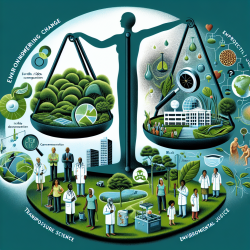Introduction
Exposure science is a multidisciplinary field that seeks to understand the nature and extent of human exposure to environmental contaminants. However, traditional approaches have often fallen short in addressing the needs of marginalized communities disproportionately affected by these exposures. The research article, "An applied environmental justice framework for exposure science," proposes a transformative approach to exposure science by integrating environmental justice principles. This blog will explore how practitioners can implement these outcomes to improve their skills and encourage further research.
Understanding the Environmental Justice Framework
The environmental justice (EJ) framework emphasizes the fair treatment and meaningful involvement of all people, regardless of race, color, national origin, or income, in environmental decision-making. This approach calls for researchers to engage with communities, understand their concerns, and collaboratively develop sustainable interventions. By centering the community's needs and incorporating their "funds of knowledge," researchers can design studies that are culturally and ethically responsible.
Implementing the Framework in Practice
Practitioners can improve their skills by adopting the following strategies:
- Community Engagement: Actively involve community members in the research process, from identifying exposure issues to developing interventions. This participatory approach ensures that research addresses real-world concerns and builds trust.
- Shared Decision-Making: Collaborate with community stakeholders to prioritize research questions and design studies that reflect their needs and values. This approach fosters a sense of ownership and accountability.
- Sustainable Interventions: Develop interventions that are culturally appropriate and sustainable. This requires understanding the community's social, cultural, and economic context and leveraging local resources.
- Data Sharing and Transparency: Ensure that research findings are accessible to the community and that data ownership is shared. This transparency builds trust and facilitates the translation of research into policy and practice.
Encouraging Further Research
The EJ framework highlights the need for ongoing research to address the root causes of environmental health disparities. Practitioners are encouraged to explore the following areas:
- Structural Racism: Investigate how structural racism contributes to differential exposures and health outcomes. This research can inform policies that address systemic inequities.
- Intersectionality: Examine how multiple forms of marginalization intersect to affect exposure and health outcomes. This approach can reveal hidden disparities and inform targeted interventions.
- Community-Driven Research: Support community-led research initiatives that empower marginalized communities to document and address their environmental health concerns.
Conclusion
Implementing an environmental justice framework in exposure science can lead to more equitable and effective research outcomes. By engaging with communities, sharing decision-making, and developing sustainable interventions, practitioners can drive meaningful change in health outcomes. To further explore the research article and its implications, please follow this link: An applied environmental justice framework for exposure science.










